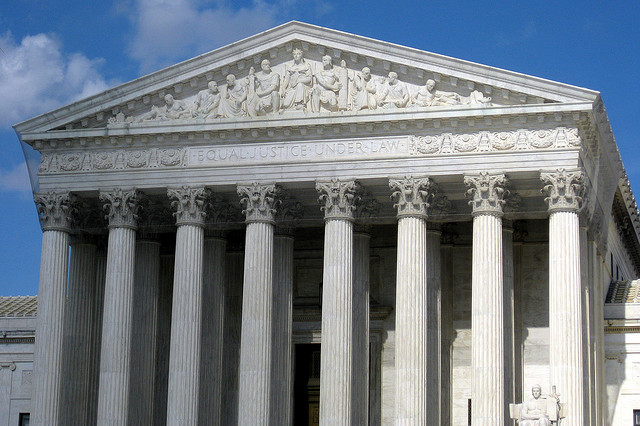
The Wall Street Journal trotted out well-worn myths, many provided by the conservative lobbying group the U.S. Chamber of Commerce, to complain about the latest attack on class action lawsuits currently in front of the Supreme Court.
On March 5, the Supreme Court heard oral arguments in Halliburton v. Erica P. John Fund, a case that could make it more difficult for a class of shareholder plaintiffs to file lawsuits against corporations who commit fraud. At issue in this case is the “fraud on the market” theory, which was established by the Court in a 1988 case called Basic v. Levinson. The fraud on the market theory unremarkably assumes that a company's stock price reflects the information publicly available about that company -- including any false statements made by the CEO or other corporate officer. The fraud on the market theory allows plaintiffs to form a class action and sue based on that fraud, which have artificially inflated the stock price.
The WSJ, for its part, would like the Court to overturn Basic and get rid of this highly effective method of protecting everyday Americans from corporate fraud.
In a March 6 editorial, the paper essentially repeated all of the Chamber's talking points it presented at its February 28 event dedicated to the Halliburton lawsuit, including the idea that the only beneficiaries of securities litigation are plaintiffs lawyers, and that these class actions unfairly punish shareholders.
From the editorial:
Plaintiffs lawyers have dined out for years on the windfall of securities class-action suits, a species that has proliferated even as other class actions have failed. On Wednesday the Supreme Court revisited the case that started it all and now can restore some economic rationality to these suits.
[...]
A new study for the Chamber of Commerce's Institute for Legal Reform found that class actions cost the economy some $39 billion a year, while shareholders only make $5 billion off the litigation. Almost all of the money paid to shareholders comes in settlements, which merely ding one set of shareholders to pay another, with the plaintiffs lawyers taking a cut. The irony that all of this is justified in the name of “efficient markets” would be hilarious if it weren't so economically destructive.
[...]
The best outcome would be to overturn Basic so plaintiffs in securities cases would have to prove individual harm the way plaintiffs in other class actions do. If that's too much precedent toppling for the Chief, he can at least require some evidence of price movement resulting from a misstatement before a class is formed. The Basic standard has never been codified by Congress and remains a creation of the Justices. The High Court ought to be willing to revisit its economic mistakes as much as its legal ones.
The WSJ's assertion that securities class action lawsuits and settlements “merely ding one set of shareholders to pay another,” is an incomplete and misleading argument, that completely fails to take into account the financial cost of the fraud itself. The Chamber has pushed this same talking point and many of the others the WSJ featured in its editorial. But according to a report from non-profit consumer advocacy group Public Citizen, this so-called “circularity argument” ignores the “incentive effects” of this kind of securities litigation:
The evidence shows that the Chamber's “circularity” argument -- the contention that private securities actions simply transfer money from one innocent investor to another -- is flawed because it ignores incentive effects. The threat of civil liability leads officers and directors (who are often shareholders themselves) as well as large investors to establish procedures to reduce the incidence of fraud in the first place. Long-term shareholders in particular, such as institutional investors, comprise an integral part of the mechanism that deters managerial fraud. Indeed, the fact that institutional investors support private securities lawsuits shows that the circularity argument is false.
The claim that securities lawsuits are abusive and meritless does not withstand scrutiny, either. The evidence shows that, even before legislative reforms enacted in 1995, securities lawsuits were generally meritorious. Since 1995, the meritorious nature of suits has only become clearer. Nearly two-thirds (64%) of class actions are resolved after a court has adjudicated a motion to dismiss, which is a preliminary legal indicator that the suit has some merit. If anything, the evidence is that “highly meritorious suits are brought, but settled for too little.”
The Public Citizen report also shuts down the idea that securities class actions are “economically destructive,” as the WSJ puts it. According to the report, “private securities lawsuits deter malfeasance, compensate investors, and help ensure the integrity of the markets, while simultaneously enabling individual consumers who have purchased stock to seek redress in a way that would not otherwise be possible.” Indeed, studies show securities class actions are at least as strong a deterrent as the enforcement efforts of the U.S. Securities and Exchange Commission (SEC), who also strongly warned the Supreme Court not to overturn Basic.
Not only that, but long-term institutional investors -- those the WSJ purports to be so concerned about -- also filed an amicus brief in support of the continued vitality of the fraud on the market theory. As explained by the Council of Institutional Investors, the country's leading association of pension funds, endowments, and foundations, whose current intvestments depend on honest corporate governance, “If the Supreme Court overturns the 'fraud on the market' presumption, institutional investors will face serious impediments to pursuing securities-fraud lawsuits, whether class actions or individual suits ... A robust private remedy for securities fraud is critical to achieving Congress's aims of deterring fraud and recouping investor losses.”
Unless you're the Chamber, however, the WSJ isn't listening.